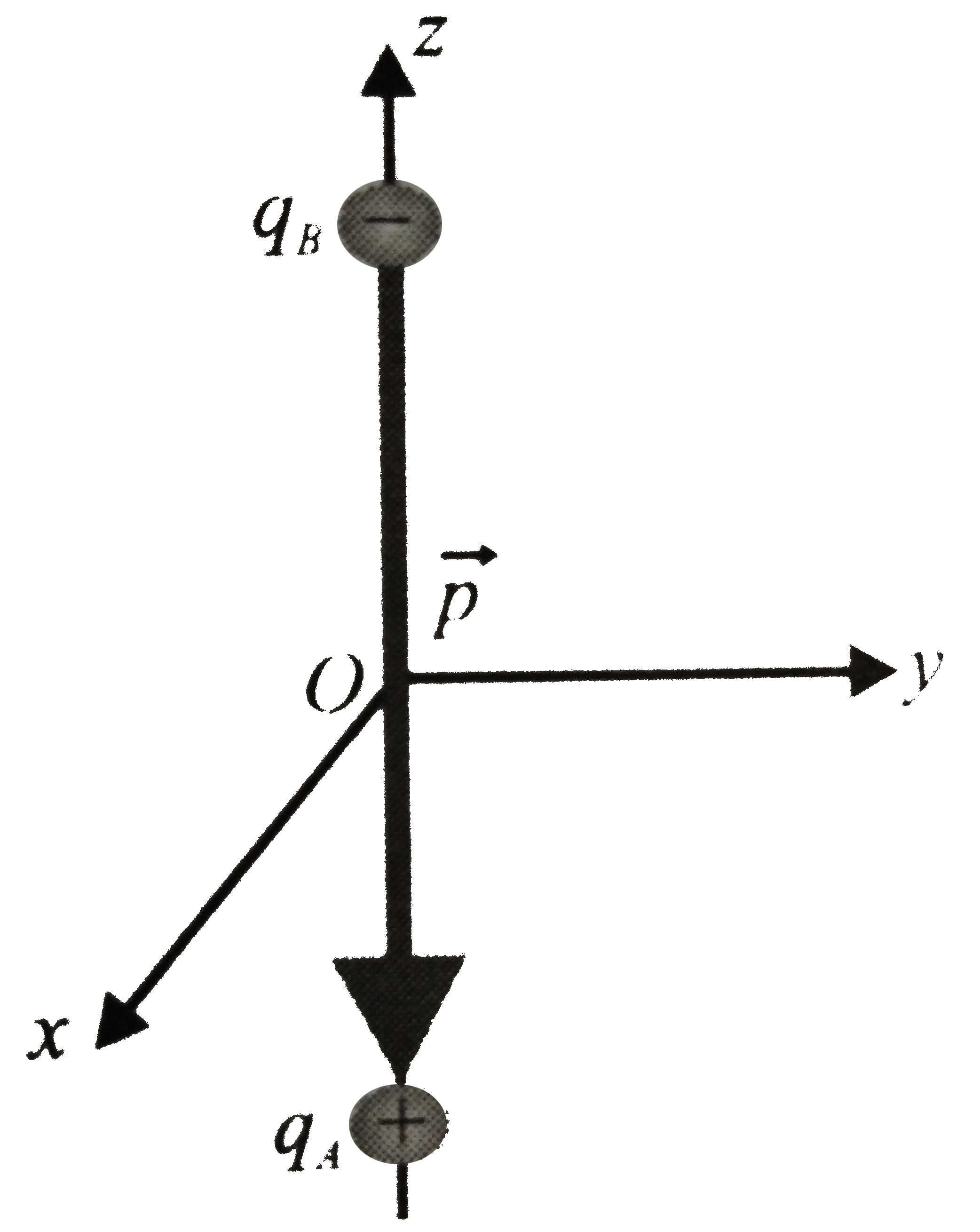'Two short dipoles pˆk and p2ˆk are located at (0,0,0) and (1(~m),0,2(~m)), respectively. The resultant electric field due to the two dipoles at the point (1,m,0,0) is 4np32πɛ0k. Find n.
The correct Answer is:7
To solve the problem, we need to calculate the electric field at the point (1, 0, 0) due to two dipoles located at (0, 0, 0) and (1, 0, 2). The dipole moments are given as p and p/2 respectively.
1. Identify the Positions of the Dipoles:
- Dipole 1 (p) is located at (0, 0, 0).
- Dipole 2 (p/2) is located at (1, 0, 2).
2. Calculate the Distance from Each Dipole to the Point (1, 0, 0):
- For Dipole 1: The distance r1 from (0, 0, 0) to (1, 0, 0) is:
r1=√(1−0)2+(0−0)2+(0−0)2=1m
- For Dipole 2: The distance r2 from (1, 0, 2) to (1, 0, 0) is:
r2=√(1−1)2+(0−0)2+(0−2)2=2m
3. Calculate the Electric Field due to Each Dipole:
- The electric field E due to a dipole at a point along the axial line is given by:
E=14πϵ0⋅2pr3
- For Dipole 1 (p):
E1=14πϵ0⋅2p13=2p4πϵ0^k
- For Dipole 2 (p/2):
E2=14πϵ0⋅2(p/2)23=14πϵ0⋅p8=p32πϵ0^k
4. Determine the Resultant Electric Field:
- Since both electric fields are in the same direction (along +k), we can add them:
Etotal=E1+E2=2p4πϵ0+p32πϵ0
- To combine these, we need a common denominator:
Etotal=16p32πϵ0+p32πϵ0=17p32πϵ0^k
5. Compare with Given Result:
- We know from the problem statement that the resultant electric field is:
Etotal=4np32πϵ0^k
- Setting the two expressions for the electric field equal gives:
17p32πϵ0=4np32πϵ0
- Canceling p32πϵ0 from both sides (assuming p≠0):
17=4n
- Solving for n:
n=174=4.25
Final Answer:
n=4.25
- Dipole 1 (p) is located at (0, 0, 0).
- Dipole 2 (p/2) is located at (1, 0, 2).
- For Dipole 1: The distance r1 from (0, 0, 0) to (1, 0, 0) is:
r1=√(1−0)2+(0−0)2+(0−0)2=1m
- For Dipole 2: The distance r2 from (1, 0, 2) to (1, 0, 0) is:
r2=√(1−1)2+(0−0)2+(0−2)2=2m
- The electric field E due to a dipole at a point along the axial line is given by:
E=14πϵ0⋅2pr3
- For Dipole 1 (p):
E1=14πϵ0⋅2p13=2p4πϵ0^k
- For Dipole 2 (p/2):
E2=14πϵ0⋅2(p/2)23=14πϵ0⋅p8=p32πϵ0^k
- Since both electric fields are in the same direction (along +k), we can add them:
Etotal=E1+E2=2p4πϵ0+p32πϵ0
- To combine these, we need a common denominator:
Etotal=16p32πϵ0+p32πϵ0=17p32πϵ0^k
- We know from the problem statement that the resultant electric field is:
Etotal=4np32πϵ0^k
- Setting the two expressions for the electric field equal gives:
17p32πϵ0=4np32πϵ0
- Canceling p32πϵ0 from both sides (assuming p≠0):
17=4n
- Solving for n:
n=174=4.25
n=4.25
Topper's Solved these Questions
Similar Questions
'Two short dipoles pˆk and p2ˆk are located at (0,0,0) and (1(~m),0,2(~m)), respectively. The resultant electric field due to the two dipoles at the point (1,m,0,0) is 4np32πɛ0k. Find n.
View SolutionTwo point dipoles pˆk and P2ˆk are located at (0, 0, 0) and (1m, 0, 2m) respectively. Find the resultant electric field due to the two dipoles at the point M(1m, 0, 0)
[−(7P32π∈0)ˆk]
View Solution
Knowledge Check
Two short dipoles pˆk and P2ˆk are located at (0,0,0) & (1m,0,2m) respectively. The resultant electric field due to the two dipoles at the point (1m,0,0) is
A9p32π∈0ˆkB−7p32π∈0ˆkC7p32π∈0ˆkDnone of theseTwo short dipoles pˆk and P2ˆk are located at (0,0,0) & (1m,0,2m) respectively. The resultant electric field due to the two dipoles at the point (1m,0,0) is
A9p32πε0ˆkB−7p32πε0ˆkC7p32πε0ˆkDnone of theseTwo small electric dipoles each of dipole moment pˆi are situated at (0,0,0) and (r,0,0). The electric potential at a point (r2,√3r2,0) is:
Ap4π∈0r2B0Cp2π∈0r2Dp8π∈0r2
[" Two point dipoles "],[phat k" and "(p)/(2)hat k" are located at "(0,0,],[0)" and "(1m,0,2m)" respectively."],[" if the resultant electric field "],[" due to the two dipoles at the "],[" point "(1m,0,0)" is "x(-(7)/(8)kphat k)" ."],[" Where "k" is electro static "],[" constant.Find "x" ? "]
View SolutionTwo point charges of, 1 μC and -1 μC are kept at (-2 m, 0) and (2 m, 0) respectively. Calculate the electric field at point (0, 5 m).
View Solution4.A electric dipole of dipole moment →p=9ˆi+3ˆj−3ˆk is placed at the point M(2 ,-3 ,1) .If the electric potential due to this dipole at the point B(4 ,-1, 0) is N times 109 volt.Then find N if the given data is in S.l units
View SolutionA system has two charges qA=+2.5×10−7CandqB=−2.5×10−7C located at point A: (0,0,-15 cm)and B: (0,0,+15 cm), respectively. What are the total charge and electric dipole moment of the system?

View SolutionA dipole of dipole moment →P=(2ˆi−3ˆj+4ˆk) is placed at point A(2 -3 1) .The electric potential due to this dipole at the point B(4 -1 0) is equal to ( All the parameters specified here are in S.I units) n×109 volts .
View Solution
